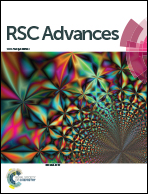Two azobenzene derivatives CAB/ACB as reusable sunscreen: UV absorptive capacity and biosafety evaluation†
Abstract
Exposure to UV radiation may cause harmful effects to the skin such as damage, aging and cancer, which can be prevented by using sunscreens. Here, two azobenzene derivatives, 4-cholesterocarbonyl-4′-(N,N,N-triethylaminebutyloxyl bromide) azobenzene (CAB) and 4-cholesterocarbonyl-4′-(N,N-diethylaminebutyloxyl) azobenzene (ACB) were studied as reusable sunscreen candidates. Biocompatibility studies including apoptosis, cytotoxicity and in vivo phototoxicity revealed that the two compounds were rather safe, except ACB, which showed a weak phototoxicity in vitro. Both CAB and ACB have good UV absorption capacity not only in their solution state (dimethylsulfoxide, DMSO) but also in the cosmetic cream state. A commercial sunscreen, avobenzone was decomposed upon UV irradiation and lost its UV protection ability, while that of CAB and ACB could be quickly recovered upon visible light irradiation, implying that they can serve as a new type of reusable sunscreen.



 Please wait while we load your content...
Please wait while we load your content...